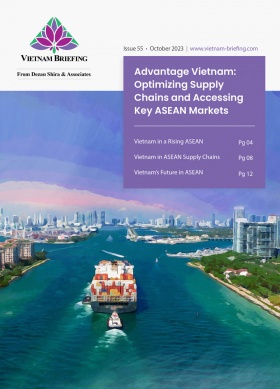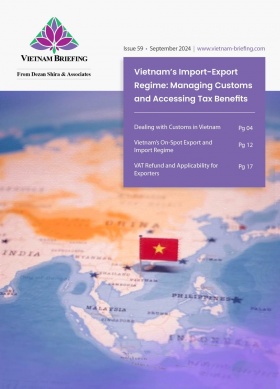Vietnam’s Natural Resource Tax 2024
Vietnam’s mining industry is receiving a huge amount of interest from foreign miners on reports that the country possesses the third-highest reserves of rare earths. Companies engaged in the extraction of natural resources in Vietnam are subject to tax obligations on these resources, which are detailed below.
Rare earth mining in Vietnam was at the top of the agenda when the President of the United States was in Vietnam back in September 2023. Keen to reduce its dependence on China for these unique metals, the US has been looking for alternative suppliers, and with what is estimated to be the third-largest rare earth reserve in the world, Vietnam has emerged as one possible option.
These resources, however, are limited. And, as with most countries around the world, recognizing the finite nature of these resources, the Vietnamese government has developed a set of natural resource taxes. These are largely dependent on the type of resource to be extracted and are sometimes used as an incentive to develop particular areas of resource extraction. For example, oil and gas, and coal projects often receive discounted tax rates to encourage development in these sectors (See table below).
These taxes are outlined in Resolution No. 084/2015/UBTVQH13.
See also: Vietnam’s Rare Earth Mining Industry: An Overview
Who pays Vietnam’s natural resources tax?
Industries are liable for national resource tax (NRT) if they are using or developing Vietnam’s natural resources, such as metallic and non-metallic minerals, crude oil, natural gas, petroleum minerals, forest products (except for animals), aquatic products, natural water, and swallow’s nests.
Details of the specific payees are as follow:
- For enterprises that are a part of a joint venture basis, the joint venture enterprise will pay the tax;
- For foreign and Vietnamese parties joined by a business cooperation contract to exploit natural resources, the contract should specify the entity responsible for paying the tax; and
- For small-sized organizations and individuals exploiting and selling natural resources to other organizations and individuals that commit to declare and pay the NRT on behalf of the natural resource exploiter, the purchaser will pay the tax.
Bookkeeping for tax declaration
According to Decree 11/VBHN-BTNMT dated January 30, 2024, organizations and individuals exploiting minerals must comply with bookkeeping requirements specified in this Decree to declare actual output for calculating mineral resource tax, as well as to determine annual exploitation output in periodic reports to send to tax authorities. The required documents are classified into technical or financial categories.
Technical documents:
- Book recording the volume of raw minerals and the volume of waste rock and soil (if any);
- Blasting passport, industrial explosives warehouse delivery note;
- Acceptance minutesof the volume of each mining technical stage, including soil preparation, excavation, transportation, and disposal of rock;
- Land use status quo map and transect mapping of the mineral exploitation area; and
- Results of measurement, loss calculation, and impoverishment of minerals.
Financial documents:
- Purchase invoices/warehouse delivery notes for raw materials and fuel supplied to each mining technical stage, including soil preparation, excavation, transportation, and disposal of rock;
- Sales invoices/delivery notes for raw minerals transported outside the mineral exploitation area;
- Contract for sale of raw minerals or minerals that have been processed;
- Acceptance minutes of mineral volume; and
- Liquidation of mineral trading contracts.
Natural resources tax rates
Tax rates vary depending on the natural resources being exploited and are applied to the production output at a specified taxable value per unit. Various methods are available for the calculation of the taxable value of the resources, including cases where the commercial value of the resources cannot be determined.
General tax rates
| Type of natural resources | Tax rates (%) |
| Metallic minerals | |
| Iron | 14 |
| Manganese | 14 |
| Titan | 18 |
| Gold | 17 |
| Rare earth | 18 |
| Platinum, silver, and tin | 12 |
| Wolfram and antimony | 20 |
| Lead and zinc | 15 |
| Aluminum and bauxite | 12 |
| Copper | 15 |
| Nickel | 10 |
| Cobalt, molybdenum, mercury, magnesium, and vanadium | 15 |
| Other metallic minerals | 15 |
| Non-metallic minerals | |
| Soil exploited for ground leveling and work construction | 7 |
| Rock and gravel | 10 |
| Rock used for lime baking and cement production | 10 |
| White marble | 15 |
| Sand | 15 |
| Sand used for making glass | 15 |
| Soil used for making bricks | 15 |
| Granite | 15 |
| Refractory clay | 13 |
| Dolomite and quartzite | 15 |
| Kaolin | 13 |
| Mica and technical quartz | 13 |
| Pyrite and phosphorite | 10 |
| Apatite | 8 |
| Serpentine | 6 |
| Pit anthracite coal | 10 |
| Open-cast anthracite coal | 12 |
| Lignite and fat coal | 12 |
| Other coals | 10 |
| Diamond, ruby, and sapphire | 27 |
| Emerald, Alexandrite, and precious black opal | 25 |
| Adrite, rhodolite, pyrope, berine, spinel, and topaz | 18 |
| Bluish purple, greenish-yellow, and orange
crystalline quartz; chrysolite, precious white and scarlet opal; feldspar; birusa; and nephrite |
18 |
| Other non-metallic minerals | 10 |
| Natural forest products | |
| Timber of Group I | 35 |
| Timber of Group II | 30 |
| Timber of Group III | 20 |
| Timber of Group IV | 18 |
| Timber of groups V, VI, VII, VIII, and of other groups | 12 |
| Tree branches, top, stumps, and roots | 10 |
| Firewood | 5 |
| Bamboo of all kinds | 10 |
| Sandalwood and calambac | 25 |
| Anise, cinnamon, cardamom and licorice | 10 |
| Other natural forest products | 5 |
| Natural aquatic resources | |
| Pearl, abalone, and sea cucumber | 10 |
| Other natural aquatic resources | 2 |
| Water | |
| Natural mineral water, natural thermal water, and refined natural water, bottled or canned | 10 |
| Natural water used for hydropower generation Natural water used for production and business | 5 |
| Surface water | |
| Production of clean water | 1 |
| Other purposes | 3 |
| Groundwater | |
| Production of clean water | 5 |
| Other purposes | 8 |
| Natural swallow’s nests | 20 |
| Other resources | 10 |
Natural gas, coal, and crude oil
| Volume | Standard | Incentivized |
| Crude oil | ||
| Up to 20,000 barrels per day | 10 | 7 |
| Above 20,000 barrels to 50,000 barrels per day | 12 | 9 |
| Above 50,000 barrels to 75,000 barrels per day | 14 | 11 |
| Above 75,000 barrels to 100,000 barrels per day | 19 | 13 |
| Above 100,000 barrels to 150,000 barrels per day | 24 | 18 |
| Above 150,000 barrels per day | 29 | 23 |
| Natural gas and coal gas | ||
| Up to 5 million m3 / day | 2 | 1 |
| Over 5 million m 3 to 10 million m 3 /day | 5 | 3 |
| Over 10 million m 3 /day | 10 | 6 |
Source: Resolution No. 1084/2015/UBTVQH13 [Link to Vietnamese language document]
Resource extraction for foreign firms
Foreign investment in resource extraction in Vietnam is permitted and there are a number of foreign firms already operating in several different sectors. That said, getting started for new market entrants can be daunting.
Natural resource extraction involves a number of government departments and a lot of red tape. From environmental impact reports to site clearance, to local approvals, and taxes, there are a myriad of hurdles foreign firms may need to jump. With this in mind, foreign firms that need support accessing Vietnam’s natural resources industries should contact the local, boots-on-the-ground business advisory experts at Dezan Shira and Associates.
(This article was originally published in November 2023. It was last updated on October 24, 2024.)
About Us
Vietnam Briefing is published by Asia Briefing, a subsidiary of Dezan Shira & Associates. We produce material for foreign investors throughout Asia, including ASEAN, China, and India. For editorial matters, contact us here and for a complimentary subscription to our products, please click here. For assistance with investments into Vietnam, please contact us at vietnam@dezshira.com or visit us at www.dezshira.com.
Dezan Shira & Associates assists foreign investors throughout Asia from offices across the world, including in Hanoi, Ho Chi Minh City, and Da Nang. We also maintain offices or have alliance partners assisting foreign investors in China, Hong Kong SAR, Dubai (UAE), Indonesia, Singapore, Philippines, Malaysia, Thailand, Bangladesh, Italy, Germany, the United States, and Australia.
- Previous Article Setting Up an FDI Company in Hung Yen Province, Vietnam
- Next Article E-Invoice Compliance in Vietnam: Regulations, Requirements, and Best Practices








